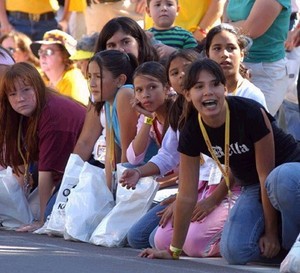No other type of photography can have quite the same impact as that of taking pictures of people. This is obviously due to the psychological impact that viewing such images has on the people that view them. Almost any clear image that includes people will carry some impact, because human beings are so expressive. To take truly meaningful images of people, however, especially with your digital camera, consider the following ten tips:
1 – Your subject. Nothing will have more influence on the outcome of your photographs than that of selecting your subject. They may be young, or old, of one race or another. You may have one person in the photo or many. You might be taking a picture of a complete stranger or someone who is very close to you. The thing to keep in mind, regarding your subject is the fact that the type of subject you choose should have some bearing on the way you photograph them. For example, the lighting you choose should take into consideration skin tone. Too much light with fair skinned people will tend to cause them to look washed out. Distance too matters. The closer you are to your subject the more detail you will see in their features. For older people, you might want to back up a bit so as to not accentuate lines and wrinkles. Virtually every photography tip regarding photographing people is based first on your subject.
2 – Lighting. Other than subject, lighting is the most important thing to consider when photographing people, especially when using a digital camera. The reason this is so critical is because the more available light, the faster the shutter opens and closes. Faster shutter speeds mean sharper images, because they mitigate slight jiggling by the person holding the camera. In short, the more light, the more clear your pictures will turn out. Lighting can be used for other reasons too of course, such as setting mood or highlighting skin tone, both of which are learned mostly through experience. If you plan to take pictures of people, do so as often as you can, and every time you do so, try changing the lighting around to see what effect is produced.
3 – Distance. The closer your subject, the more clarity you can expect. What may not be apparent however, is the change in intimacy. Moving your camera in close to your subject, crosses personal boundaries and captures much more personality than do pictures taken at a traditional distance. Try moving in close enough to capture just your subjects eyes, or just their face. Have them tilt their head, or let their hair fall down over their face. Have them smile, or frown, or look off into the distance. Not every picture must have the subject staring directly into your lens.
4 – Posing. There are two kinds of subject photographs. Posed or candid. Posed pictures are where the photographer tells the subject where and how to stand, sit, or lay. Candid pictures are of the subject doing as they wish, generally without pretense. The type you choose will depend on what you are trying to capture. Posed photographs tend to focus more on the physical characteristics of the subject, while candid shots tend to focus on something the subject is doing. The important thing to remember when choosing not only whether to take candid or posed pictures, or what types of poses you want, is to try to capture honesty. Forced poses, for example, generally looked forced. As another example, asking people to stand awkwardly while you take their picture, will give you far different results from asking someone to straddle a chair and glare at you. The point is, take into consideration the point of view of your subject, their feelings and their comfort zone. For the most part, people tend to look best in photographs when allowed to be themselves.
5 – Planning. For the most part, taking good photographs of people requires some planning. Consider for example the difference in impact of impromptu photographs taken at a graduation or other event, versus those taken of the same person beforehand in the studio. The more you plan, the more you can control. With photography, the more you can control, the more likely you are to produce the types and quality of pictures you desire.
6 – Mood. One of the things you cannot control, is the mood of your subject. Certainly, if you’re funny, you might be able to cause them to smile. But it’s not guaranteed. Everyone has their own moods, and you might or might not want to capture the one your subject is currently experiencing. Also, they may or may not feel like sharing it with you. But if they do, it’s up to you to capture it in a flattering or at least interesting way. As the person holding the camera, you have a bit of power in your hands. You can make people look good or bad. You can exploit emotion for your own sake, or produce something your subject will be proud of. It’s up to you. Mood is a very difficult thing to capture, but the results can be powerful, especially when handled with care.
7 – Ambiance. As the photographer, you have the option of choosing the ambiance you want. This includes the environment, the lighting, even the settings on your camera. You might prefer to shoot in black and white to accentuate the deep lines in someone’s face. Or you might want the warm diffused sunlight of a late summer sunset. It’s the ambiance of a photograph that elicits emotion in the person looking at the results. The best advice I can give regarding ambiance is to try as many different settings as often as you can. There is no better way to learn to anticipate the ambiance of your photographic efforts than practice.
8 – Personal appearance. In some photographs, you might want your subject to look a certain way. Glamour shots for example, usually go along with models wearing make-up and with their hair done just so, and wear particular clothes. Your subject may also want some input. It all depends on the desired result. Also keep in mind the coloring of the clothes your subject wears. Bright colors tend to distract from the subject. Also, you might consider the effect of the color of the clothes as they relate to the color of your subject’s skin or hair. Finally, you might also want to remember that you have the ability to accentuate strong features, and to lesson those that aren’t as flattering by aiming your lens thoughtfully, paying attention to lighting and by choosing your distance carefully.
9 – Equipment. Most any digital camera is technically capable of giving you good solid images. You don’t need to buy a very high end camera to take really good pictures. As most anyone who has been taking pictures for any length of time will tell you, good pictures come from good photographers. Having said that, there are some pieces of equipment you can buy that will help improve the quality of your pictures. One is a tripod. No matter how steady you think your hands are, you’ll get better results with a tripod. Another is lights. Photography stores sell lights whose purpose is to help you take clear, evenly lighted portraits. Using them not only helps light your subject, but they also help to eliminate red-eye. Another thing you can do is add memory. Almost every model of digital camera has a means for adding memory. Doing so allows you to shoot pictures at the maximum resolution, which means bigger sharper pictures and more of them.
10 – Number of pictures. One of the main advantages of digital photography over film is that you can take a virtually unlimited number of pictures of any given subject. Digital cameras free us from having to worry about the cost of film and developing. Use that advantage. Take as many pictures as your subject can stand. You can always delete the ones that don’t turn out well. Also, while taking a lot of pictures, make a lot of changes. For example, you might take a couple pictures of a subject standing a certain way. Then, move yourself just enough to change the angle slightly. Or increase or decrease the light slightly. With digital photography, you can make hundreds of miniscule changes as you snap away. There is no fear of cost involved. The law of averages says the more pictures you take, the more good pictures you’ll find in your results.
These ten tips have been presented to help photograph people well with your digital camera. If you are interested in improving your results, please always remember, the best thing you can do is to take a lot of pictures, and while doing so, change things to see what works and what doesn’t. Try to view the pictures you’ve taken on a computer screen as soon after you’ve taken them as possible so you’ll remember what you did to get that result. And above all, don’t be afraid to try new things. Experiment, improvise, take risks. Imagine yourself as if you were unconstrained by convention. In the end, you’ll no doubt find yourself taking more and more pictures that will make you proud. Good luck with all your efforts.






